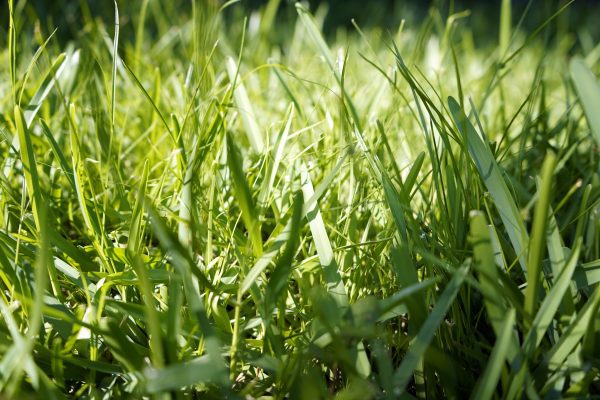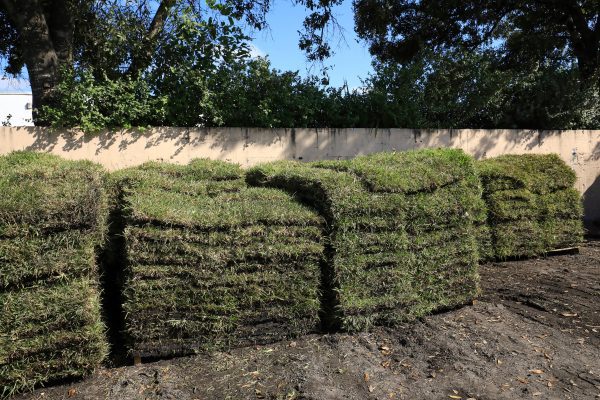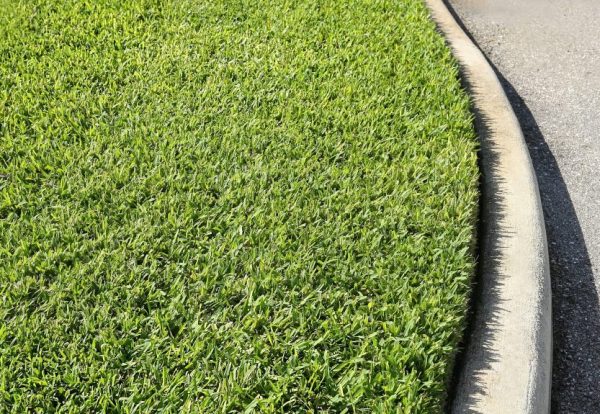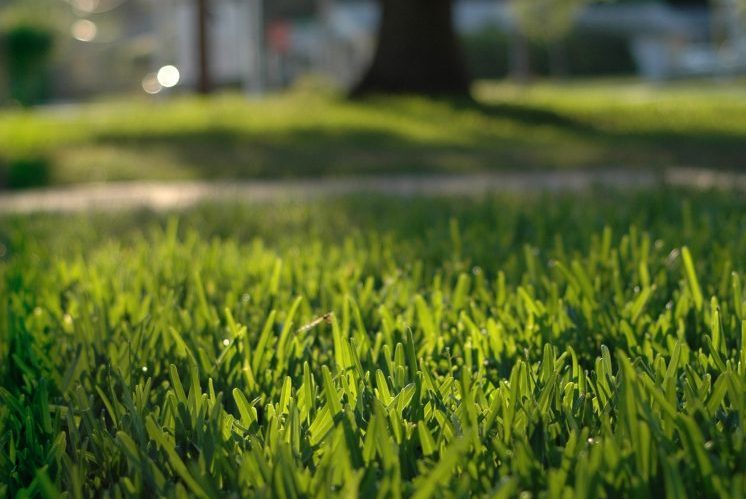Lawn & Garden

Learn the characteristics of various St. Augustinegrass cultivars along with requirements for grass establishment, maintenance, and control of pests and diseases.
St. Augustinegrass (Stenotaphrum secundatum) is a coarse-textured, warm-season turfgrass that is adapted to warm, humid regions. This turfgrass is believed to be native to the coastal regions of the Gulf of Mexico and the Caribbean.
Before planting St. Augustinegrass, it is important to determine first if it is right for your landscape environment and then to know how to maintain it in a thriving state.
Advantages & Disadvantages of St. Augustinegrass
Compared to other warm-season turfgrasses, St. Augustinegrass is shade tolerant and can produce a lawn in shady areas for a few years. It requires irrigation during drought and moderate fertilization. St. Augustinegrass can be grown in a wide variety of soils but grows best in soils that are well drained and fertile.
Although St. Augustinegrass is less cold tolerant than other warm-season turfgrasses, it stays green longer in the fall after the first frost. The use of St. Augustinegrass in Alabama is somewhat limited to the southern half of the state due to the turf’s poor cold tolerance; however, cold tolerance varies between different varieties. St. Augustinegrass has a high salt tolerance, which makes it suitable for coastal areas.
St. Augustinegrass has certain cultural and pest problems that limit its use. It has poor wear tolerance, and some homeowners dislike its coarse leaf texture. Producing a high-quality St. Augustinegrass lawn requires supplemental irrigation and fertilization. Too much fertilization can cause excessive thatch accumulation and other pest problems. The major insect pest of St. Augustinegrass is the chinch bug. While certain cultivars of the grass have resistance, chinch bugs (Blissus spp.) typically overcome the plant’s resistance over time.
St. Augustinegrass Varieties
Common
Common St. Augustinegrass has been grown since the 1800s and produces a coarse-textured, open lawn that is susceptible to chinch bugs and herbicides, cold, and shade damage. Phenoxy herbicides, such as 2,4-D and MCPP, should never be applied to this turfgrass. Common St. Augustinegrass is light green in color and does not respond well to fertilization. This grass is not often recommended for home lawns.
‘Bitterblue’
‘Bitterblue’ is an improved variety selected from common St. Augustinegrass in the 1930s for its finer leaf texture, darker blue-green color, and better density. It has improved cold and shade tolerance compared to common St. Augustine, but it is not resistant to chinch bugs or gray leaf spot disease (Pyricularia grisea). ‘Bitterblue’ has lower tolerance to the triazine herbicides (atrazine, simazine) than other St. Augustinegrass varieties have. It should be mowed to a height of 3 to 4 inches.
‘Raleigh’
 This variety was released by the North Carolina Agricultural Experiment Station in 1980 for its improved cold hardiness. It can be grown throughout Alabama and has survived cold temperature exposure as low as minus 20 degrees F.
This variety was released by the North Carolina Agricultural Experiment Station in 1980 for its improved cold hardiness. It can be grown throughout Alabama and has survived cold temperature exposure as low as minus 20 degrees F.
‘Raleigh’ has a coarse leaf texture, is susceptible to chinch bugs and large patch and gray leaf spot diseases, and is less shade tolerant than ‘Bitterblue’. ‘Raleigh’ has been noted to turn yellow during peak summer temperatures, and its growth slows during cooler temperatures. It should be mowed to a height of 3 to 4 inches.
‘Palmetto’
This variety was isolated from a sod farm in Florida and patented by the company Sod Solutions in 1995. It has dark-green leaves and good drought and cold tolerance. It can be mowed a little lower than many other St. Augustinegrass varieties, at 2 to 3 inches.
‘CitraBlue’
‘CitraBlue’ was released in 2019 by the University of Florida and is a semi-dwarf type, meaning it can be mowed to a height of 2 to 3 inches. It has good tolerance to the diseases large patch, take-all root rot (Gaeumannomyces graminis graminis), and gray leaf spot. Its resistance to chinch bugs is still being evaluated as of fall 2020. It has a unique blue-green color and a dense canopy.
Establishing St. Augustinegrass
St. Augustinegrass spreads laterally across the soil surface by aboveground stems called stolons. Currently, all St. Augustinegrass varieties are established vegetatively as sprigs, plugs, or sod, with sod being recommended for lawn establishment. The best time to plant St. Augustinegrass is during its active growth period, normally between May and August.
The most important aspect of establishing any lawn is the preparation of the soil. To do this, till the area to be planted, rake and remove plant debris and rocks, and take several random scoops of soil to submit for lab testing (see “Home Soil Testing” at www.aces.edu). The test report will describe the soil pH and fertility levels of the soil area. Apply lime and/or fertilizer as recommended by the soil test report and till it into the soil to a depth of 4 to 6 inches. Rake the future lawn area until smooth and thoroughly moisten it to help in the establishment process.
Sprigging and Plugging
Repairing bare spots in a St. Augustinegrass lawn can be done by sprigging or plugging.
With sprigging, it is important to use freshly harvested sprigs (stolons) that have at least two nodes, or joints. Plant the sprigs in rows that are 6 to 12 inches apart. Cover the sprigs lightly with soil, press firmly around the sprigs, and leave a tip of each sprig exposed. These exposed leaves stimulate rooting. Keep the sprigs moist until they have become rooted and established. Ensure survival and establishment by watering daily in the absence of rainfall for at least 2 weeks. To accelerate the sprig’s grow-in period, increase the number of sprigs planted per unit area.
Plugs can be obtained from a commercial grower or cut from sod into square or circular plugs. Space plugs 6 to 12 inches apart in 6-to-12-inch–wide rows. The closer together the plugs are placed, the faster the turfgrass will grow in. Place the plugs in holes that are the same size and dimension as the plugs. Tamp the plugs into place so that they are level with the soil surface. Ensure the survival and establishment of the plugs by watering daily for at least 2 weeks in the absence of rainfall.
Sodding
 Sodding is the best and most common option for establishing a lawn because it produces an “instant” lawn and reduces soil erosion. Soil preparation for sodding is the same as for sprigging and plugging.
Sodding is the best and most common option for establishing a lawn because it produces an “instant” lawn and reduces soil erosion. Soil preparation for sodding is the same as for sprigging and plugging.
Lay the sod over bare, moist soil in a staggered pattern such as that used in bricklaying. Stagger the sod pieces in rows and place the edges tightly together so that there are no cracks. On a slope, lay the sod squares across or perpendicular to the grade of the slope. If there are any cracks between the pieces, fill them with soil or sand to prevent dips in the future lawn. Roll the sod to smooth the surface, and thoroughly water it to ensure faster rooting. Water newly sodded areas daily in the absence of rain until the sod is established and well rooted.
Maintaining St. Augustinegrass
As for any turfgrass, the level of maintenance it is given has a direct effect on the quality of the lawn. Quality is a subjective term based on personal preferences. It is often defined by the uniformity of green color, growth density, and leaf texture seen across the turfgrass area. Many people prefer turfgrass with medium-to-dark– green color (depending on genetic capability), dense growth, and finer leaf texture. Others prefer the coarse, wide-leafed texture of St. Augustinegrass.
Fertilizing
A good-quality St. Augustinegrass lawn requires a properly planned fertilization program. Periodic soil testing should be conducted every 2 to 3 years as the basis for major applications of lime, phosphorous (P), and potassium (K). This helps to maintain the proper and potassium at recommended levels. Soil testing is not used to determine nitrogen (N) requirements for turfgrasses; this is based on the plant type (table 1).
Table 1. Suggested Nitrogen Fertilization Schedules for St. Augustinegrass Lawns
| Amount of Nitrogen per 1,000 ft.2 | April | May | June | July | August |
|---|---|---|---|---|---|
| Standard (Option 1) | 1 pound | 1 pound | |||
| Standard (Option 2) | 1⁄2 pound | 1⁄2 pound | 1⁄2 pound | 1⁄2 pound | |
| Maximum | 1 pound | 1 pound | 1 pound | 1 pound |
Nitrogen-containing fertilizers stimulate leaf growth, resulting in a darker green lawn. The more N that is applied, the more the turfgrass grows; however, N must be applied in a balanced manner to achieve consistent, even growth patterns. In addition, the more the lawn grows, the more often it must be mowed, and more maintenance is required.
Ammonium sulfate, urea, and other water-soluble nitrogen fertilizers are often used on St. Augustinegrass lawns; however, these fast-release nitrogen fertilizers will burn turfgrass if applied too heavily or if applied to wet turf. To avoid burning the turf, do not apply more than 1 pound of actual nitrogen per 1,000 square feet per fertilizer application. Always ensure that the turf is dry and irrigate the fertilizer immediately after application. If a soil test recommends applying P and/or K, a complete fertilizer may be used (e.g., 16-4-8); otherwise, P and K should be absent in the fertilizer used. Nitrogen-only fertilizers are available in most retail stores.
Since fertilizers vary in their nitrogen content, the amount of fertilizer needed to supply 1 pound of nitrogen depends on the source used. Use a fertilizer calculator to determine how much of your favorite fertilizer is required to get 1 pound of actual nitrogen. A calculator is available on the Auburn University Soil, Forage & Water Testing Laboratory website at https://aaes.auburn.edu/soil-forage-water-testing-lab/.
Slow-release nitrogen fertilizers do not readily dissolve in water, but they can be applied at higher application rates and not burn the turf. Turf maintains its green color over a longer period of time with slow-release fertilizers and has more consistent and even growth. Slow-release nitrogen sources also are preferred because they are less susceptible to leaching and runoff, especially for sandy soils and lawns near surface water (lakes, streams, rivers). Slow-release nitrogen sources include sulfur-coated urea (SCU), polymer-coated urea (PCU), isobutylidine diurea (IBDU), urea formaldehyde (UF), methylene urea (MU), and natural organics such as manure. Read more about protecting water quality, water sheds, and Smart Yards at www.aces.edu.
The amount and frequency of fertilizer applications depend on the amount of traffic on the grass, the level of desired quality, and the type of fertilizer used. Table 1 shows suggested standard and maximum nitrogen fertilization schedules for St. Augustinegrass lawns based on the level of maintenance and quality desired.
For a lower maintenance lawn of good color and density, it is recommended that a total of 2 pounds of actual nitrogen per 1,000 square feet of lawn be applied per year. There are two standard options for application: (1) apply 1 pound of nitrogen per 1,000 square feet once in May and once in July or (2) apply 1⁄2 pound of nitrogen per 1,000 square feet once per month in May, June, July, and August.
The maximum fertility recommendation for St. Augustinegrass lawns is a total of 4 pounds of actual nitrogen per 1,000 square feet of lawn applied annually. To reach this annual rate, apply 1 pound of nitrogen per 1,000 square feet once per month in April, May, July, and August. For improved winter hardiness, make one application of potassium in September at 1 pound of potassium per 1,000 square feet.
Mowing
Proper mowing practices are critical to maintaining a beautiful St. Augustinegrass lawn. Older varieties of St. Augustinegrass should be mowed to 3 to 4 inches. Many newer varieties have a lower growth habit and can be mowed to 2 to 3 inches. A guideline to follow is to mow often enough so that no more than one-third of the leaf height is removed at each mowing. Depending on rainfall and soil fertility, this means using a manual mower every 7 to 14 days.
Mowing St. Augustinegrass too low can cause problems over time. Consistently low mowing reduces turf density along with the plant’s ability to recover and grow. In addition, weeds are more of a problem in thin turf, allowing bare areas for weed seeds to land in and increased sunlight to penetrate the turf canopy and stimulate weed seed germination.
Normally a rotary-type mower (manual or robotic) is used to mow wide-leaved turfgrasses, such as St. Augustinegrass, but a reel-type mower can be used. It is important to keep all mower blades sharp and well-adjusted to get the highest-quality cut. Dull mower blades give the lawn a dull appearance because they shred the leaves rather than cut them, making the leaf edges ragged. Mower blades should be sharpened or replaced monthly during peak growing months.
Turf clippings can be returned or recycled to the lawn during mowing if the lawn is being mowed at the proper mowing height and frequency to satisfy the one-third rule. Under these conditions, turf clippings do not contribute to thatch accumulation. Remove clippings only if they are wet or if the lawn has been allowed to grow too tall and the clippings are clumping during mowing.
Watering or Irrigating
Except during establishment, irrigation on an as- needed basis is an excellent way to schedule watering of any turfgrass, provided that the proper amount of water is applied when needed and not based on the homeowner’s convenience.
Irrigate once the first signs of drought stress or wilt are observed. Apply roughly 1⁄2 inch of water and avoid watering faster than it can soak into the ground. If irrigation water starts to run off the surface, turn off the irrigation and let the water soak in for at least 20 to 30 minutes before continuing. Signs of wilting include leaf blades that fold and turn bluish green in color. Another indication is visible footprints left in the grass when it is walked on. Water or irrigate early in the morning while dew is still on the lawn. Irrigating or watering during the night or evening hours can increase disease problems.
Controlling Thatch
 St. Augustinegrass can develop a layer of organic material called thatch, located between the green leaves of the turfgrass and the soil surface. This thatch layer accumulates over time. It can be caused by overfertilizing, overwatering, or mowing too infrequently. If the thatch layer is allowed to accumulate to a thickness greater than 3⁄4 inch, problems such as increased risk for drought stress or winter injury may arise. Thatch can harbor insects and disease-causing organisms, create a barrier to air and water movement, and elevate the living turfgrass plant away from the soil.
St. Augustinegrass can develop a layer of organic material called thatch, located between the green leaves of the turfgrass and the soil surface. This thatch layer accumulates over time. It can be caused by overfertilizing, overwatering, or mowing too infrequently. If the thatch layer is allowed to accumulate to a thickness greater than 3⁄4 inch, problems such as increased risk for drought stress or winter injury may arise. Thatch can harbor insects and disease-causing organisms, create a barrier to air and water movement, and elevate the living turfgrass plant away from the soil.
Check the thickness of the thatch layer by cutting a small triangle or square in the turfgrass using a knife or shovel. Remove this plug and look at the soil beneath the green turfgrass plants. The thatch layer is brown to black in color and has a different appearance from the native soil beneath.
If the thatch layer is thicker than 3⁄4 inch, mechanically dethatch the lawn in the spring, any time from late May through August. It is recommended to delay dethatching until the turfgrass has completed green-up after winter dormancy and begun to initiate vigorous spring growth.
Use a core aerifier, aerator, vertical mower, power rake, or spring attachment for a mower to remove thatch. Routine thatch removal should not be needed annually if other recommended maintenance practices are applied.
Controlling Pests & Diseases
Insects
Several pests can affect St. Augustinegrass lawns. The most serious insect pest is the chinch bug. This insect can be controlled with chemicals (insecticides) or, the better option, by planting a newer variety of St. Augustinegrass that has genetic resistance to the pest. Be aware, however, that chinch bugs eventually will defeat the resistance factor in many of these St. Augustinegrass varieties.
Other insect pests of St. Augustinegrass include sod webworms, armyworms, and mole crickets. Several insecticides are available to control these pests. See Extension publication IPM-1314, “Home Lawns: Insects, at www.aces.edu.
One or more of these pests will need monitoring throughout the year if a higher-quality lawn is desired. Contact your county Extension office or the Master Gardener Helpline at (877) 252-4769 for diagnoses and recommendations for treating landscape and garden pest problems.
Diseases
St. Augustinegrass lawns are susceptible to several plant diseases, the most common of which are large patch and gray leaf spot. A good maintenance program can minimize the occurrence of most disease problems. However, if the lawn is infected there are several fungicides that can be used to manage major disease outbreaks. See Extension publication IPM-1292, “Home Lawns: Disease Control: at www.aces.edu.
Nematodes
Several types of nematodes attack St. Augustinegrass lawns. These microscopic soilborne worms attack the roots of turfgrass plants and, if not controlled, can kill the entire lawn.
Nematodes cause the lawn to turn yellow in color and become thin, especially during hot, dry periods. Nematodes can cause extensive damage to lawns, particularly on sandy soils and where high maintenance is performed.
Once nematodes have been identified as a serious problem, there are several options for treating them, but these must be done by certified pesticide applicators and can be expensive. Maintaining a healthy lawn and minimizing other stress factors is the most practical management of nematodes in home lawns. Irrigate weekly during periods of drought, keep fertility levels adequate, monitor other potential pests, and keep the mowing height within the recommended range. Practices that increase root health and rooting depth are especially important.
Weeds
Well-managed St. Augustinegrass lawns typically do not have many weed problems because the grass is so dense it naturally prevents weeds from establishing. However, if weeds become a problem, the lawn has probably become thin and weakened by improper maintenance or damage from pests.
Use caution with herbicides on St. Augustinegrass because it is sensitive to many of them and may be injured. Herbicides that contain 2,4-D and MCPP, known as the phenoxies, are commonly used in other turfgrasses; however, these often damage St. Augustinegrass.
Herbicide injury is most severe during spring transition, the green-up phase between dormancy and a fully green lawn. Misapplication (e.g., high rate, spray pattern overlap, etc.) during the spring can kill a St. Augustinegrass lawn. Always read and follow the label recommendations for herbicides and pesticides before applying them. See Extension publication IPM-0590, “Home Lawns: Chemical Weed Control at www.aces.edu.
 Revised by Kerry Smith, Outreach Programs Administrator, Home Grounds, Gardens, and Home Pests, Auburn University. Originally written by Austin Hagan, Professor Emeritus, and Jeffery M. Higgins, former Extension Turfgrass Specialist, both with Auburn University.
Revised by Kerry Smith, Outreach Programs Administrator, Home Grounds, Gardens, and Home Pests, Auburn University. Originally written by Austin Hagan, Professor Emeritus, and Jeffery M. Higgins, former Extension Turfgrass Specialist, both with Auburn University.
Revised May 2023, St. Augustinegrass Lawns, ANR-0262

